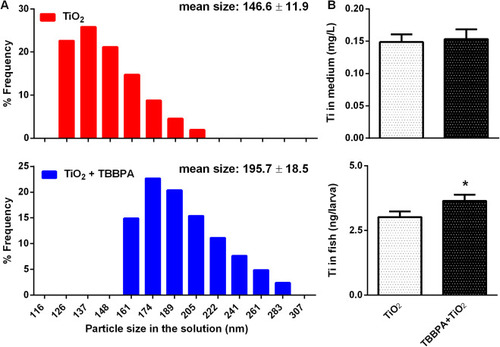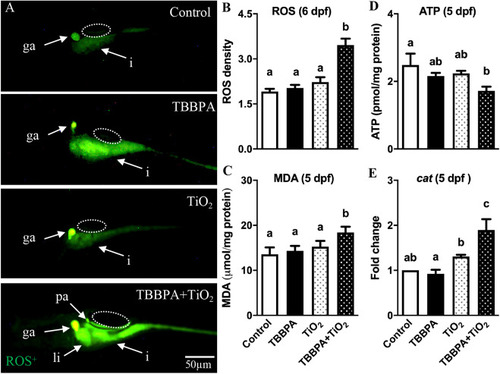- Title
-
Developmental co-exposure of TBBPA and titanium dioxide nanoparticle induced behavioral deficits in larval zebrafish
- Authors
- Chen, J., Li, J., Jiang, H., Yu, J., Wang, H., Wang, N., Chen, S., Mo, W., Wang, P., Tanguay, R.L., Dong, Q., Huang, C.
- Source
- Full text @ Ecotoxicol. Environ. Saf.
|
TiO2 NPs size distribution in medium and level in larvae. Zebrafish embryos were exposed to 0.1 mg/L TiO2 NP and TiO2 NP with 2 µM TBPPA mixture from 8 to 120 hpf and exposure medium and larvae were sampled for TiO2 analysis. (A) Particle size analysis of exposure medium collected at 24 h after treatment. (B) TiO2 level in the medium collected at 24 h after treatment (n = 3) and exposed larvae at 120 hpf (n = 3, 20 larvae per replicate). Values plotted are mean ± SEM and *P < 0.05 using unpaired t-test analysis. |
|
Effect of TBBPA and TiO2 NP on motor behaviors. Zebrafish embryos were exposed to 0.1% DMSO control, 2 μM TBBPA, 0.1 mg/L TiO2 NP and TBPPA/TiO2 NP mixture from 8 to 120 hpf and motor behaviors were evaluated at different developmental stages. (A) Spontaneous movement (expressed as tail bents/min) at 24 hpf (n = 24). (B) Touch response in dechorionated embryos at 48 hpf (n = 24). (C-D) Free swimming activity (expressed as swim speed) at 5 dpf during a 10-min light period followed by a 10-min dark period (n = 24). Values plotted are mean ± SEM and bars sharing the same letter indicate no significant difference at the level of P < 0.05 using one-way analysis of variance (ANOVA) followed by Tukey’s multiple comparison test. |
|
Effect of TBBPA and TiO2 NP on larval light/dark preference and shoaling behaviors. Zebrafish embryos were exposed to 0.1% DMSO control, 2 μM TBBPA, 0.1 mg/L TiO2 NP and TBPPA/TiO2 NP mixture from 8 to 120 hpf and then washed three times before raising in clean fish water under standard care procedures. (A-B) Larvae at 10 dpf were used to assess light/dark background preference test (n = 24). (C-D) Larvae at 11 dpf were used to assess shoaling behaviors (n = 20). NND: nearest neighbor distance; IID: inter-individual distance. Values plotted are mean ± SEM and bars sharing the same letter indicate no significant difference at the level of P < 0.05 using one-way analysis of variance (ANOVA) followed by Tukey’s multiple comparison test. |
|
Effect of TBBPA and TiO2 NP on larval mirror attack and social contact behaviors. Zebrafish embryos were exposed to 0.1% DMSO control, 2 μM TBBPA, 0.1 mg/L TiO2 NP and TBPPA/TiO2 NP mixture from 8 to 120 hpf and then washed three times before raising in clean fish water under standard care procedures. (A-B) Larvae at 12 dpf were used to assess the mirror attack response (n = 24). (C-D) Larvae at 13 dpf were used to assess the social contact behaviors (n = 12 paired fish). Values plotted are mean ± SEM and bars sharing the same letter indicate no significant difference at the level of P < 0.05 using one-way analysis of variance (ANOVA) followed by Tukey’s multiple comparison test. |
|
Effect of TBBPA and TiO2 NP on cell apoptosis. Zebrafish embryos were exposed to 0.1% DMSO control, 2 μM TBBPA, 0.1 mg/L TiO2 NP and TBPPA/TiO2 NP mixture from 8 to 120 hpf. Larvae were harvested immediately after exposure and used for cell apoptosis analysis. (A) Representative images showing acridine orange (AO) staining for larvae at 5 dpf. (A’) Images of the head region (within the white square in A) at a higher magnification. (B) The number of AO positive neuromasts in the lateral line system of 5 dpf larvae. (C-D) Quantification of AO staining density in the olfactory (C) and yolk region (D) (n = 20). (E) Gene expression fold changes of cell apoptotic marker caspase 8 (casp8) at 120 hpf (n = 3, each replicate consists pooled RNA sample from 20 larvae). The dashed elliptical area marked the swim bladder region. olf: olfactory epithelium; neu: neuromast; mou: mouth; y: yolk region. Values plotted are mean ± SEM and bars sharing the same letter indicate no significant difference at the level of P < 0.05 using one-way analysis of variance (ANOVA) followed by Tukey’s multiple comparison test. |
|
Effect of TBBPA and TiO2 NP on oxidative stress. Zebrafish embryos were exposed to 0.1% DMSO control, 2 μM TBBPA, 0.1 mg/L TiO2 NP and TBPPA/TiO2 NP mixture from 8 to 120 hpf. Larvae harvested immediately after exposure at 5 dpf were used for MDA, ATP, and cat analysis and larvae 6 dpf were used for ROS in vivo staining. (A) Representative images showing reactive oxygen species (ROS) staining with the cell membrane-permeable ROS marker 2′,7′-di-chlorodihydrofluorescein diacetate (H2DCF-DA). (B) Quantification of ROS staining density (n = 20). (C) Lipid peroxidation expressed as malondialdehyde (MDA) by using whole larval homogenate from pooled larvae at 5 dpf (n = 6 replicates with each replicate pooled from 20 larvae). (D) Adenosine triphosphate (ATP) measured using whole larval homogenate from pooled larvae at 5dpf (n = 6 replicates with each replicate pooled from 20 larvae). (E) Gene expression fold changes of antioxidant enzyme catalase (cat) at 5 dpf (n = 3, each replicate consists pooled RNA sample from 20 larvae). The dashed elliptical area marked the swim bladder region. ga: gallbladder; pa: pancreas; i: intestine; li: liver. Values plotted are mean ± SEM and bars sharing the same letter indicate no significant difference at the level of P < 0.05 using one-way analysis of variance (ANOVA) followed by Tukey’s multiple comparison test. |






